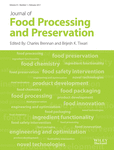Approaches to Removal and Killing of Salmonella Spp. Biofilms
Abstract
This study aims to assess the effectiveness of three sanitizers (an alkaline solution, an acid solution and a quaternary ammonium salt) to remove biofilm formed by Salmonella spp. on stainless steel surfaces. To evaluate the individual or combined effects of sanitizer concentration, time (5.0–25 min) and temperature (25–65C) on survival of Salmonella spp. biofilms three different Central Composite Designs (CCD) were developed. Results highlighted that treatments containing NaOH were able to eliminate more than 82–83% of sessile population, whereas the total removal of biofilm was obtained using a solution at least 800 ppm for 15 min at 45C. Peracetic acid seemed to be more effective than NaOH assuring the total removal of biofilm at low temperature. Even the quaternary ammonium salt was able to remove completely Salmonella spp. biofilms at 60C using a solution at 12 ppm, or at higher temperature (65C), using a less concentrated solution (6 ppm).
Practical Applications
Due to the wide range of contributing factors (surface type, availability of nutrients and oxygen, microbial species, etc.) biofilms are quite diverse; in essence it can be said that each biofilm is different. Even if numerous attempts have been made to find standardized systems to prevent, remove and kill biofilm cells, until now there is no unique system that is able to remove all biofilms. Thus, a study on the factors affecting the resistance of Salmonella spp. biofilms against sanitizers may be useful into the development of new sanitation strategies in food industries.




